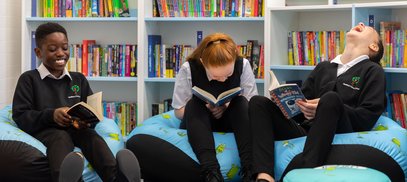As we settle into the new school year, we’re excited to share guidance on how to introduce your pupils to the school library in the latest blog in our series, Library Lifeline, written in association with the School Library Association.
This series is designed to support anyone working in a school library by answering their questions directly. If you have a question that you’d like to ask our ‘agony aunt’ – the SLA’s Member Development Librarian, Dawn Woods – then please email us at worldofstories@literacytrust.org.uk and your question may be the focus of a future blog!
After being out of use for some time, we have newly set up our library and want to encourage pupils to embrace the space as well as reading for pleasure this year. Do you have suggestions about how we can help them become familiar and comfortable in this new environment?
Primary school TA/part time school librarian
Library Induction
A new academic year brings new faces and completely dazed children relying on you to show them what to do. Showing your pupils that the library is there to offer them comfort and a safe place to discover books is a great way to help reassure them.
When children are first faced with a school library, even if it consists of perhaps three bays of books whilst you may wish you had more room for shelving and more budget for books, those three bays are possibly more books than the child has ever seen together before. Children need reassurance that they can remove books from the shelves, they can look inside and if they don’t feel it is for them, they can put it back and select another.
Choosing books
If this is not structured enough for pupils, offer even more scaffolding when choosing and familiarizing themselves with various titles. Perhaps start by having a few books spread out on a table. Pick one up and show them how to explore their interest in that book.
Look at the cover – what does it suggest to you?
Read the blurb – does it sound interesting to you?
Look inside – can you or someone else read it to you? Does it have illustrations and from those alone does it make you happy?
It may be a story; it could be an information book. If so, how can they tell what it is about? If the child is unable to read the title, you could prompt them to spot clues to the subject on the cover?
Handling books
Let your pupils see you handling books in the library so that you model careful handling and not simply looking. Perhaps include an activity for making a bookmark so they can make their own to mark their reading place rather than put the book open pages face down or fold down corners! Seemingly small steps like this can significantly strengthen children’s library usership behaviors and confidence in handling books.
Share your reading journey and ask them about books they’ve enjoyed – whether they have been shared by a teacher or read independently. This informal book-talk helps pupils feel heard and increases their comfort in the library space.
Familiarity with space
If children are entering a new key stage this may be the first time they have been in the library.
Older children may be more familiar with this space but a recap on where different types of books are located is useful and removes the barrier of children not being able to find material they will enjoy.
Allow time for them to search for books so you can see who is more familiar with searching and who needs more help.
Information Literacy Skills
If you have a planned library skills programme this is the opportunity to teach the next skills in them becoming independent learners. There is a suggested Library Curriculum on the SLA website for members. https://www.sla.org.uk/members-benefits
Above all inject some fun into these library ‘lessons’. A treasure hunt around the library searching for different types of books will cement learning whilst being more interactive and memorable.
Invite parents to choose books with their children perhaps before or after school weekly or on specific dates.
Have a display of books about change including changing schools, classrooms, etc. For younger children you can read them a story about starting school showing that school is not a vast scary place but somewhere safe with staff who care. A read-aloud session with whatever age your pupils are helps to reassure children, creating a positive and welcoming experience for them in the library.
A thriving, welcoming library can truly help to change a pupil’s experience of belonging in school, and the whole school community’s approach to reading for enjoyment.
